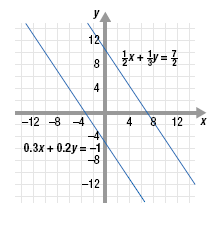|
Solving Linear Systems of Equations by EliminationUse elimination to find the solution of this system.
To make the equations easier to work with:
When the result is a false statement, the graphs of the equations never intersect. The graph confirms that the lines are parallel and have no points in common. This system has no solution because the lines never intersect. The system is inconsistent. (It has no solution.) The equations of the system are independent. (Their graphs are not identical.)
When using either substitution or elimination, if both variables are eliminated there are two possible outcomes: • If the resulting equation is an identity, such as 5 = 5, then the lines coincide.
• If the resulting equation is a false statement, such as 0 = 4, then the lines are parallel and never intersect.
|
| Copyrights © 2005-2025 |




